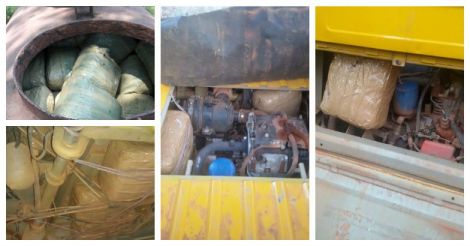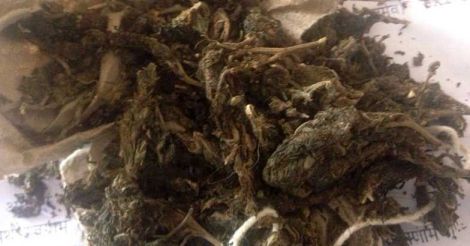Why would an educational institution spend Rs 1.5 lakh on a sniffer dog? The excise officer was curious about the sale of the dog in Kollam. Little did he know that he was on the trail of a narcotics racket that has engulfed schools and colleges in Thiruvananthapuram and other parts of Kerala.
The college had bought the dog to keep a check on the packs of ganja that flowed freely into the campus every day. Any amount of counseling and disciplinary action would not force the students to mend their ways. The college was in a fix. A police complaint would mark it as a den of ganja smokers. A sniffer might help.
This was not an isolated experience. A team of sleuths formed by the excise commissioner to strike at the root of the ganja trade in south Kerala was floored by a racket that operated out of the Thiruvananthapuram Central railway station at Thampanoor. The special squad kept the gangs of the city on watch for several months. Yet they could not trace the routes of smuggling.
One day, one of the officers got a tip-off. A large deal was about to take place somewhere on the suburbs of the city. That information led to one of the largest ganja hauls in Kerala. The sleuths seized 418 kilos of ganja neatly packed and stacked in tamarind sacks. These packages had been couriered into Kerala from Tamil Nadu and Andhra Pradesh.
The courier service employees were shocked to hear that they have been carrying the contraband unknowingly all these while. The client they nicknamed as the "Tamarind King" was the mastermind of ganja smuggling in Kerala.
Shanu had found an ingenious way to smuggle the weed. He would wet the weed and press them into little blocks. They would be wrapped in plastic sheets and stacked into the sacks of tamarind, ready to be shipped into Kerala. The camouflage worked perfectly well for months. The sacks kept coming in on trains. Even if someone opened them, all that was visible were dried tamarinds.
Outsourcing ganja production
Idukki has shaken off its tag as a ganja producing region, but the hilly district still retains its reputation as a major hub of ganja smuggling. Hashish oil worth Rs 22 crore was seized from Idukki in six months. New-generation sellers can’t wait until the weeds are matured and processed. More importantly, there are no forests left to plant in.
The ganja peddlers just have to take a trip to Cumbum or Salem in neighboring Tamil Nadu to ensure a steady supply. In case the order is so huge, they might have to travel to Andhra Pradesh, where agents on the other end of the line would be ready to supply ganja and hashish oil in any volume.
Ganja is cheaper in Andhra. A kilo of weeds would cost only Rs 4,500. The margin would be as much when the contraband is sold in Kerala.
Ganja supply to Kerala is ensured by the proximity of Cumbum just across the border. The extent of the ganja trade was laid bare with the arrest of Sankiri from Salem by the Kerala Excise Department in association with the Tamil Nadu special branch police.
He was a big shark who found his name featured on the list of 11 dealers who smuggle over 1,000 kilos of ganja regularly to Kerala. His son Kubendran is in jail in Visakhapatnam for smuggling 400 kilos of ganja.

The Vadakkeppatti area in Cumbum, just under the nose of the North police station, is haven to more than 1,000 ganja peddlers, the police estimate. The Tamil Nadu police hardly take any action on these petty criminals, while Kerala cops are helpless in cracking on them across the border.
Intoxicating cottage industry
Ganja is not hard to get in the small towns and villages of Kerala. Anyone can procure the weeds at ease. Excise officers recount a raid on a residential apartment in Kochi. They had received a tip-off that ganja was even grown in one of the houses.
The information turned out to be correct. The offender had cultivated ganja plants in half of his bathroom, with an imported light installed over them to supplant sunlight.
The Excise Department hates to admit that the increase in the instances of ganja seizures in Kerala had anything to do with the closure of bars in the state. Even the Social Justice Department rules out any such connection. Ganja is preferred to alcohol by many, they say. And there is a variety of reasons.
Ganja does not reek like alcohol. The weed is easy to carry and roll into a cigarette or bidi. Most of the times, its use goes undetected. Yet the intoxication is prolonged than that of spirits. A misinformation campaign that ganja is less harmful than alcohol and a weird notion that the weed tickles the brain into creativity add to its demand.
Ganja is accessible anywhere anytime. The peddlers work overtime because the margin is so high. And most importantly, fraying family relations send people drifting towards the intoxicating smoke.
Whatever the reason, Kerala is seeking out new ways of intoxication, data shows. The use of ganja and drugs are increasing day by day. If government-owned liquor outlets competed among themselves for higher sales once upon a time, the change in demand forces ganja smugglers of Andhra Pradesh and Orissa to slug it out for a larger market share.
Liquor recedes
The number of cases the Kerala Excise Department registered under the Narcotic Drugs and Psychotropic Substances Act (NDPS Act) rose from 332 in 2011-12 to 4015 in 2015-16. The volume of ganja seized in the state rose from 813.7 kilos in 2011-12 to 953 kilos in 2015-16.
The number of plants destroyed rose from 15 in 2011-12 to 823 in 2015-16. The number of vehicles seized rose from 44 to 303 in the same period.
Since April 2014, when the bars were closed down in Kerala, liquor sales have decreased in the state, shows a survey conducted by Alcohol and Drug Information Centre (ADIC India) based on data released by the Kerala State Beverages Corporation (KSBC). The state government decided in 2013-14 to close down all bars except those rated four or five stars. As many as 418 bars were closed down the next year after a favorable court ruling.
The government policy in 2015-16 resulted in the closure of all bars except the five-star ones.
The government also decided to close down 10 percent of KSBC outlets every year, but retained the licenses of 730 beer and wine parlors.
The sales of "Indian-made foreign liquor" fell from 21,56,29,420 liters in 2013-14 to 19,69,74,271 liters in 2014-15 and 17,99,51,672 liters in 2015-16.
While liquor sales decreased by 5,43,32,897 liters, the consumption of beer and wine skyrocketed. Wine consumption rose by 10,42,398 liters and beer sales increased by 2,87,77,377 liters.
If Kerala consumed 6,35,871 liters of wine in 2013-14, the amount rose to 7,71,308 liters in 2014-15 and 15,42,832 liters in 2015-16.
The consumption of alcohol has fallen by 22.11 percent since the bars were ordered to close down. ADIC India has urged the government to replicate this model with beer by closing down the beers parlors too.
(To be continued)
























